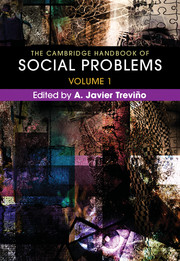Book contents
- The Cambridge Handbook of Social Problems
- The Cambridge Handbook of Social Problems
- Copyright page
- Contents
- About the Contributors
- Introduction
- Part I General Concerns and Orientations in the Study of Social Problems
- Part II Historical and Theoretical Issues in the Study of Social Problems
- Part III Problems of Discrimination and Inequality
- Chapter 17 Racism
- Chapter 18 Immigration
- Chapter 19 Gender Inequality
- Chapter 20 Sexualities and Homophobia
- Chapter 21 Poverty and Income Inequality: A Cross-National Perspective on Social Citizenship
- Chapter 22 Housing Market Discrimination
- Chapter 23 Hunger and Food Insecurity
- Chapter 24 Ageism, Past and Present
- Chapter 25 Disabilities
- Part IV Problems of Institutions
- Index
- References
Chapter 23 - Hunger and Food Insecurity
from Part III - Problems of Discrimination and Inequality
Published online by Cambridge University Press: 16 March 2018
- The Cambridge Handbook of Social Problems
- The Cambridge Handbook of Social Problems
- Copyright page
- Contents
- About the Contributors
- Introduction
- Part I General Concerns and Orientations in the Study of Social Problems
- Part II Historical and Theoretical Issues in the Study of Social Problems
- Part III Problems of Discrimination and Inequality
- Chapter 17 Racism
- Chapter 18 Immigration
- Chapter 19 Gender Inequality
- Chapter 20 Sexualities and Homophobia
- Chapter 21 Poverty and Income Inequality: A Cross-National Perspective on Social Citizenship
- Chapter 22 Housing Market Discrimination
- Chapter 23 Hunger and Food Insecurity
- Chapter 24 Ageism, Past and Present
- Chapter 25 Disabilities
- Part IV Problems of Institutions
- Index
- References
Summary
In this chapter I examine hunger and food insecurity as social problems. I focus on these concerns, not as purely biological, environmental, physiological, or natural phenomena, but as being rooted in social and structural factors such as conflict, culture, development, the economy, globalization, population-demography, politics, and social stratification, among other sociological issues. From this approach, famines as the classic case of hunger, food insecurity, and deprivation in their most severe form would not be viewed as strictly the result of natural disasters or drought but as the result of social conditions that make them a human-induced catastrophe tied to politics and inequality. I begin by presenting the conceptualization of hunger and food insecurity, addressing the complexity of the issues and their multiple forms and ways of discussing them. I then provide a snapshot of the state of hunger in the world and trends that have resulted in the current condition. I close with a discussion of hunger and food insecurity in the context of what comprises social problems and consider their intersectionality with other global concerns.
- Type
- Chapter
- Information
- The Cambridge Handbook of Social Problems , pp. 423 - 440Publisher: Cambridge University PressPrint publication year: 2018



